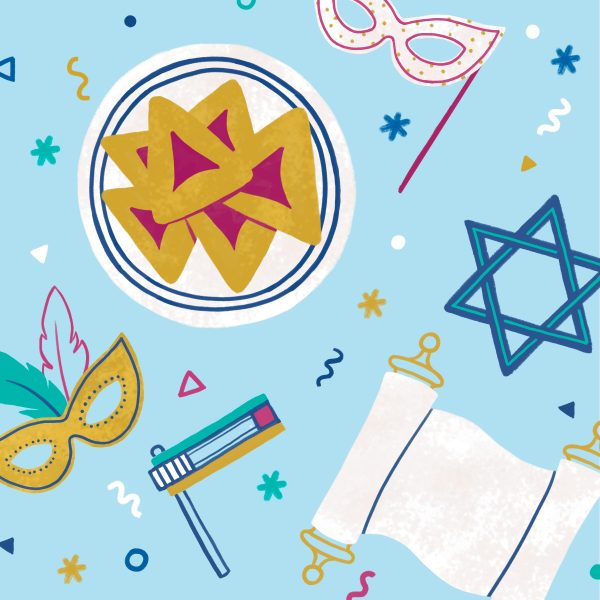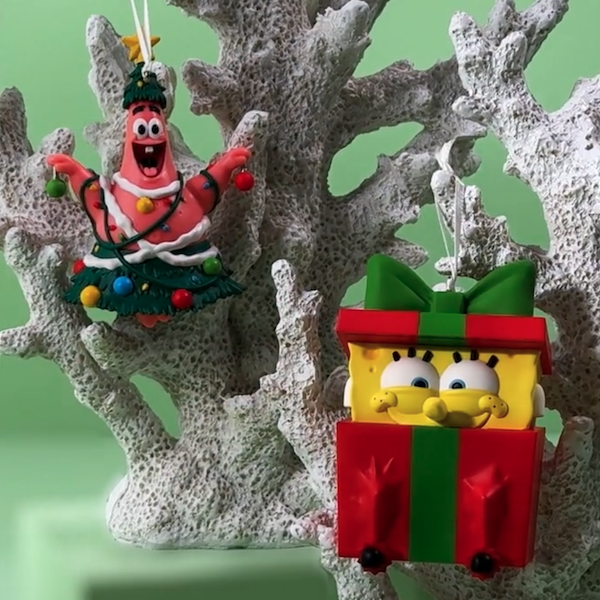What is Purim?

What is Purim? Pronounced poor-im, it’s a joyous one-day Jewish festival that honors an event detailed in the biblical Book of Esther. It takes place in the springtime, on the 14th day of the Hebrew month of Adar, which usually occurs around March. The festival celebrates bravery, courage and the importance of doing the right thing—and is a jubilant affirmation of Jewish survival.
Inspired? Create and share by tagging @HallmarkStores.
The history of Purim
Purim commemorates the story of Queen Esther of the Persian Empire rising up against hate, honoring her Jewish heritage and protecting her people.
The story begins between the fourth and fifth centuries when King Ahasuerus of Persia chooses Esther to be his queen. Esther’s cousin, Mordecai, instructs her to keep her Jewish identity a secret as this information could endanger her life. In fact, the king’s prime minister and top advisor, Haman, is a power-hungry and wicked man who, Esther soon learns, is plotting a massacre to annihilate all the Jews in the kingdom.
When Mordecai gets wind of Haman’s evil plan, he immediately contacts Esther and they decide to work together to stop Haman. Mordecai encourages Esther to come forward and reveal her Jewish identity to the king in order to save their people.
Although approaching the king unannounced—or revealing her true identity—could be punishable by death, Esther takes the risk and tells the king the truth. She pleads with him to intervene in Haman’s plot to exterminate the Jews.
The king is outraged and puts a halt to Haman’s plan and sentences Haman to death. King Ahasuerus even names Mordecai his top advisor. Soon after, there is a battle against those who wished to aid Haman in destroying the Jews and the Jews emerge victorious.
Purim celebrates the courage and bravery it took for Queen Esther to come forward and how the good actions of a few can affect many.
Traditional Purim celebrations
Costumes and performances
Kids and adults alike don clever costumes and dress up as characters from the Purim story, including King Ahasuerus, Queen Esther, Mordecai or Haman. Masks and costumes—and masquerading in general—are used in part as a nod to Queen Esther’s early concealment of her Jewish identity.
Jewish communities also celebrate Purim with carnivals and parades and perform skits, songs and plays (Purim spiel) that reenact and pay tribute to the events that occurred so long ago. During these retellings of the Purim story, audience or congregation members use noisemakers called groggers to “blot out” wicked Haman’s name each time it is uttered.
Joyous feasts and symbolic foods
It’s customary to enjoy a fun feast with friends and family and to share Purim gift baskets (mishloach manot, “sending portions”) full of breads, sweets, fruits, nuts or wine with friends or neighbors.
Some of the most popular Purim treats are hamantaschen, which translates to “Haman pockets” in Yiddish. The structure is said to be a symbol of the hat Haman wore. Hamantaschen are triangular-shaped shortbread cookies with sweet or savory fillings in the center. Popular fillings include poppy seeds, fruit jams, prunes, apricots, chocolate, cherry…the options are endless (and delicious).
Meaningful Purim traditions
Charitable giving (matanot la’evyonim)
The Book of Esther calls on Jews to donate meals or money to those in need during Purim to build friendship and goodwill and ensure all who wish to celebrate Purim with a feast have enough to do so.
Retelling the story
Reading the Book of Esther (Megillat Ester) during synagogue services on the eve of Purim is considered a mitzvah, or a commandment and good deed.
The Fast of Esther
It is customary to fast the day before Purim from dawn to dusk to represent the fasting Esther did in the days prior to approaching the king. The fast is said to allow for soul-searching, which builds strength.
Purim greetings
- Chag Purim Sameach (KHAHG poor-im sah-MEY-akh), meaning “Happy Purim!”
- Chag Sameach (KHAHG sah-MEY-akh), meaning “Happy Holiday!”
Shop Tree of Life
See allYou may also like
See more-
Valentine's Day Make little hearts happy this Valentine’s Day 💞
Nothing lights up a little one's face like letting them know just how much they're loved. Okay...except for when they...
-
Valentine's Day Valentine's Day gifts for him: 100+ ideas for the boyfriends, husbands, dads and sons in your life
Who’s ready for Valentine’s Day?! 🥰 We absolutely love this holiday and can’t think of a more perfect time to shower ...
-
Calendar Flip Spring Forward: March 2026 Holidays and Observances
Color us excited! From the wearin’ of the green and more sunny fun to colorful Holi festivals and celebrating crayons...
-
Calendar Flip Welcome a New Year: January 2026 Holidays and Observances
HAPPY NEW YEAR! If that hurt your head, you might have celebrated a little too much. When you’re feeling better, we h...
-
Calendar Flip Hello, Love: February 2026 Holidays and Observances
Let’s warm up this cold month with love and connections. From valentine cards to dressing up your pet, this month has...
-
Christmas Christmas gift wrap ideas to match your holiday personality
If you’re anything like me, the holiday season can make you tap into different sides of yourself. Maybe you become th...
-
Gifting 60+ Peanuts® Snoopy gifts to help fans channel their favorite beagle
It was a dark and stormy night in the winter of 2015. I was 17 years old, overwhelmed with AP classes, senior-year st...
-
Christmas 3 Christmas kids craft ideas, plus activities for even more easy holiday fun
From decorating the house to baking cookies, the Christmas season gives us so many opportunities to get creative and ...
-
Christmas The best Christmas gift idea: Bikini Bottom BFFs
Got a bestie who's as silly as you? Or one who's there through all of life's storms with a smile? Then we think this ...
-
Christmas Which Disney Pixar character is your favorite? 🤔
Thankfully, with so many beloved Disney Pixar character Keepsake Ornaments, you won't have to choose a favorite this ...
-
Christmas Not having Cher on your tree? As if! 💅
If you're a Millennial, we predict you will be majorly, totally, butt crazy in love with this Clueless Keepsake Ornam...
-
Christmas 20 vintage Christmas ideas to turn up the charm this holiday season
When I think of my perfect Christmas, vintage vibes are always what come to mind first. Santa’s sleigh in a dreamy wi...
-
Christmas 20+ ideas to help you plan your trip to the Hallmark Christmas Experience
Ever wanted to step inside of a picture-perfect Hallmark Christmas movie? Or travel to a place where you could immers...
-
Christmas Sit fireside with the cutest snowfolks around!
A campfire might seem like the least likely place to find a few snowmen hanging out, but if it's cold enough, even th...
-
Christmas With so much magic, we can’t choose a favorite!
Every Keepsake Ornament is magical, but our ornaments with light, sound and music are in a class all their own. From ...
-
Christmas Stocking stuffer ideas for literally everyone on your list
The stocking stuffer struggle is real. By the time you’ve bought your main presents, you feel like you’re all out of ...
-
Christmas You love Keepsake Ornaments…we love rewarding you! 🥳
Collecting Keepsake Ornaments isn't just a hobby for you—it's a passion! And that kind of enthusiasm is something we ...
-
Christmas 60+ Christmas decorating ideas to deck your halls—and every other space!
If you’re searching for Christmas decorating ideas to make all your spaces extra jolly and put you in a merry mood, y...
-
Christmas Dance your way to Christmas morning 🦛🎄
Keep little ones giggling and grooving all holiday break-long with this musical dancing Christmas hippo plush! Does i...
-
Winter Lean into the Season: winter ideas to make the season bright and extra cozy
There are two types of people in this world: those who love winter and those who’d endure an eternity of wearing wet ...





















